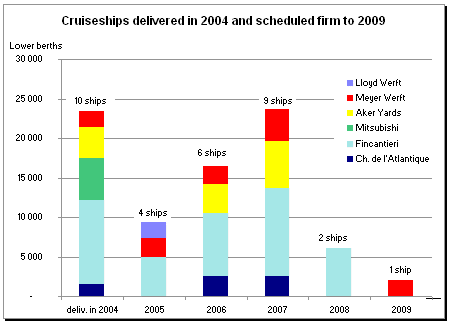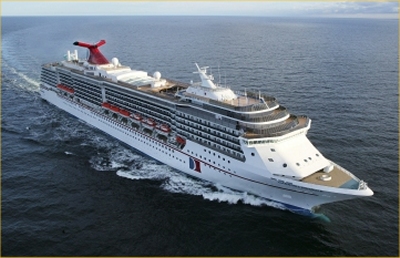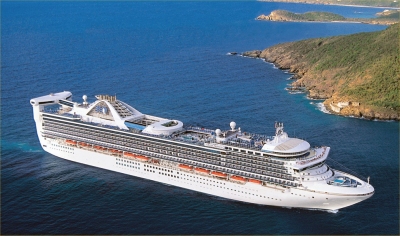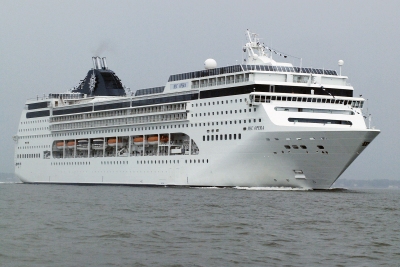
|
The Cruise market in 2004
|
|
If we were able to hand out 'Oscars' in the cruise
market, we would indisputably have two big winners this
year: the Carnival Cruise Line group, on one hand, and
Fincantieri shipyards, on the other, both having
developed a fruitful co-operation.
The Carnival group closed its annual results with a
profit of nearly $ 2 billion for a turnover of roughly
$ 10 billion, namely a net margin of 20 %. This
result confirms both the success of the merger between
the P&O / Princess group and the Carnival group, as
well as the growth of the cruise market in the US and
Europe in 2004.
Fincantieri ended the year with an orderbook of ten
cruise ships, all for the Carnival group, representing
60 % of the world orderbook and slightly over $ 5
billion in value, guaranteeing full employment for
their three cruiseship construction sites until 2008.
The enthusiasm which these magnificent results
inspire should however be tempered in a global outlook
of the market. The cruise industry has just experienced
three difficult years since the attack of September
11th, 2001 and began the year 2004 with a new
challenge, that of absorbing ten ships representing
about 23,500 lower-berths, or 10 % of the current
capacity. Once again, demand was able to match this new
supply thanks to the increase in the number of cruise
passengers which should surpass the 13 million mark in
2004.
|

|
|
At the beginning of 2004, there were only three ships to be
delivered in 2005 and four in 2006. However, despite the
continuing decline of the dollar lifting the cost of
construction in Europe, owners could not resist the
temptation to consolidate their commercial position by
ordering new ships, in this booming market.
Once again, the signal was given by Carnival who as early
as January ordered a ship, the 'Costa Concordia', 112,000
gt, 1,900 cabins, for delivery in the summer of 2006, at '
450 million, for its subsidiary Costa. In October, two ships
of 68,000 gt, 1,000 cabins, were ordered by another Carnival
affiliate, Aida, with Meyer Werft, for delivery in April
2007 and April 2008, for a unit cost of ' 315 million. But
above all, the biggest order ever placed was made with
Fincantieri for a total figure of $ 2.6 billion for four
ships to be delivered in 2007-2008 and the extension of the
future 'Queen Victoria' by 11 meters for Cunard, for a
complementary cost of $ 95 million. The four ships are
broken down as follows:
- one for Carnival, 110,000 gt, at a price of $ 500
million,
- one for Princess Cruises, 107,000 gt, at a price of $
525 million,
- two similar ships for Europe, priced respectively at '
475 and ' 490 million, with the Carnival group keeping the
option to dedicate these two ships to either of its brands
during the year 2005.
This order is exceptional in both its size and the fact
that Fincantieri agreed to deal both in dollar and in euro,
with client and supplier sharing the currency risk.
At the end of the year, Carnival thus has 12 ships on
order and in January 2005, this owner will add a sistership
of the 'Concordia' for its subsidiary Costa, for delivery in
2007 at a price of ' 475 million.
RCCL declared in September its option with
Kvaerner Masa Yard, which has become Aker Finnyards, for a
second 'Ultra Voyager' of 163,000 gt, 3,600 passengers, at a
price of ' 580 million. RCCL continues to invest in these
mega-ships with success, but it is likely that Carnival will
start to compete in this market of very large carriers,
since its 'Pinnacle' project of 180,000 gt is already on the
drawing boards.
RCCL has also opted this year for the extension of the
ship 'Enchantment of the Seas' which should see its capacity
increased by 150 cabins for a cost in the region of $ 55
million. The new section will be built at Aker
yards and installed in the Netherlands during the second
quarter of 2005.
Norwegian Cruise Line (NCL) began the year with some
concerns due to the financial losses of its mother company
in Asia and the accident of the 'Pride of America' under
construction at Lloyd Werft. Finally, the group has
successfully put in place a financial restructuring, which
allows it to raise $ 1 billion and to order two ships in
December:
- one of 92,000 gt, 1,200 cabins, for delivery in February
2007 with Meyer Werft, at a price of ' 370 million,
- the other of 89,000 gt, 1,000 cabins, with Aker
Finnyards, for delivery in the spring of 2007, with an
option for another unit to be lifted in August 2005 for
delivery in the spring of 2008, at a price of ' 385 million
per unit.
An agreement was finally signed with Lloyd Werft to take
delivery of the 'Pride of America' in June 2005, whilst the
'Norway' has definitively been stopped, awaiting a sale.
NCL, under the NCL America banner, continues to develop
its cruise business in Hawaii under the American flag,
despite some teething problems linked to restrictions with
the American flag. Four ships are still programmed for this
market over the next three years.
In Europe, the year began sadly with the demise of
Festival who should have celebrated ten years of existence
in 2004, but which allowed MSC to expand
its development policy by taking over the 'European Vision'
and 'European Stars' at a price of some ' 215 million per
unit.
Mediterranean Shipping Cruises (MSC) has become a main
competitor to Costa in Europe and also plans to consolidate
its position as European cruise operator in the American
market. Comforted by being the second largest owner of
containerships in the world, MSC does not hide their plans
to become a prime player in the European cruise scene. In
September MSC completed six months of negotiations
with Chantiers de l'Atlantique for the order of two 3,000
passenger ships, for delivery in the summer of 2006 and in
the spring of 2007, at a price of ' 400 million each, with
an option for an additional ship.
The European market should increase from 3.1 million
lower-berths in 2004 to 3.7 million in 2007, profiting from a
potential steady growth and should continue to absorb a
quarter of the world fleet. It is true that if we apply the
American model to Europe, there could be ten million cruise
passengers in ten years time.
|
|
Finally 12 ships were ordered in 2004, representing 33,000
lower-berths, plus an additional three on option.
The orderbook at the end of the year thus comprises 21
ships firmly booked, for a total of 56,000 lower-berths, or
an average capacity per ship of 2,650 passengers, of which
nine ships are of post-panamax size.
|

|
Carnival Miracle
85 700 tb, livr' en 2004 par Aker Yards, exploit' par
Carnival Cruise Line |
|
Ten new ships representing 23,500 lower-berths were
delivered during the year, of which seven went to the
Carnival group. These deliveries were broken down as
follows:
For Carnival Cruise Line:
- 'Carnival Miracle', 85,700 gt, 2,124 lower-berths, 1,057
cabins, delivery February 2004, built by Aker Finnyards
- 'Carnival Valor', 109,500 gt, 2,974 lower-berths, 1,438
cabins, delivery November 2004, built by Fincantieri
For Princess Cruises:
- 'Caribbean Princess', 112,894 gt, 2,998 lower-berths,
1,557 cabins, delivery March 2004 built by Fincantieri
- 'Diamond Princess', 115,875 gt, 2,674 lower-berths,
1,337 cabins, delivery March 2004
- 'Sapphire Princess', 115,875 gt, 2,674 lower-berths,
1,337 cabins, delivery May 2004 built by Mitsubishi
|

|
Diamond Princess
115 875 tb, livr' en 2004 par Mitsubishi, exploit' par Princess
Cruises |
|
For Costa:
- 'Costa Magica', 102,200 gt, 2,702 lower-berths, 1,358
cabins, delivery November 2004 built by Fincantieri
For Holland America Line:
- 'Westerdam', 81,769 gt, 1,848 lower-berths, 924 cabins,
delivery April 2004 built by Fincantieri
For Royal Caribbean Cruise Line:
- 'Jewel of the Seas', 90,090 gt, 2,100 lower-berths,
1,055 cabins, delivery April 2004 built by Meyer Werft
For Mediterranean Shipping Cruises:
- 'MSC Opera', 59,058 gt, 1,526 lower-berths, 795 cabins,
delivery in June 2004 built by Chantiers de l'Atlantique
|

|
MSC Opera
59 058 tb, livr' en 2004 par les Chantiers de l'Atlantique,
exploit' par MSC Cruises |
|
For Birka Line:
- 'Birka Paradise', 33,000 gt, 1,800 lower-berths, 728
cabins, delivery November 2004 built by Aker Finnyards
|
|
The revival of the cruise market during the year gave life to the
second-hand market which was enlivened by the auction sales of
vessels owned by companies in financial difficulties (notably ROC
and Festival), as well as the sale of ships from the group My
Travel (Sun Cruises) who decided to shutdown their activity as
shipowners.
These sales allowed one to gauge the relatively firm prices
which were established, partly due to the rise in the cost of
construction and to some extent due to the weakness of the
dollar.
Amongst the more notable sales were:
- 'Carousel', 23,000 gt, 1,000 lower-berths, built 1971,
'Seawing', 16,700 gt, 754 lower-berths, built 1971 and 'Sunbird'
37,773 gt, 1 414 lower-berths, 633 cabins, built in 1982
(chartered by Thomson) to the owner Louis Cruises, at
respectively $ 14, $ 9 and $ 71 million, whereas the 'Sun Dream'
23,000 gt, 1,000 lower-berths, built 1970 was sold to Caspi
Shipping.
- 'European Vision' renamed 'MSC Harmonica', and 'European
Stars' renamed 'MSC Sinfonia', 58,000 gt, 1,506 lower-berths, 783
cabins, built in 2001 and 2002, bought by Mediterranean Shipping
Cruises at the cost of '215 million each.
- 'Mistral', 47,276 gt, 1,196 lower-berths, 598 cabins, built in
1999, sold to a Spanish tour operator Viajes Iberojet for a price
of about ' 130 million.
- Iberojet also bought the 'Superstar Capricorn', 23,400 gt, 755
lower-berths, built in 1972, renamed 'Grand Latino' at a price of
$ 20 million.
- 'Superstar Aries', 37,000 gt, 611 lower-berths, built in 1981,
renamed 'Holiday Dream' was sold to Pullmantur for a price of $
44 million.
- 'Bolero', 15,800 gt, 761 lower-berths, built in 1968, renamed
'Orient Queen' was sold to Lebanese buyers at the price of $9.5
million, whilst the 'Azur', 9,200 gt, 694 lower-berths, built in
1971 was sold to the Israeli owner ManMaritime (renamed 'Royal
Iris') at a price around $ 10 million, and the 'Flamenco' bought
by Ravenscroft for $ 12.25 million at auction, has been charted
by Travelplan in Spain.
- The German financial organisation KfW, creditor of Royal
Olympic Cruise, who had bought the 'Olympia Explorer' and the
'Olympia Voyager', built in 2000 and 2002, 24,500 gt, 840
lower-berths, 27 knots, for respectively $ 82.7 million and $
97.2 million, resold the 'Olympia Explorer' for $85 million to a
maritime university, whilst the 'Olympia Voyager' was chartered
out for on a long term period with a purchase option to the
Spanish Iberojet.
- 'Paul Gauguin' was sold by the financial owner Centre Solution
to the tour operator Grand Circle/Vantage for a price in the
region of $ 40 million, but the ship should remain in service in
Tahiti for Radisson for the next two years, 2005 and 2006.
- The project easyCruise, which caused a lot of curiosity from
all the professionals in the sector, should start in the spring
of 2005 following the purchase and the transformation of
'Renaissance Two' bought for $ 7 million and transformed in
Singapore, doubling its capacity to accommodate 180 passengers.
This ship, renamed 'easyCruise 1' will serve as a test to the
promoter, Stelios Haji-Iouannou, to develop on a much larger
scale the ambitious project of easyCruise, which is planning to
expand the range of products offered in the cruising industry in
trying to capture a much younger clientele.
- The sister ship, ex 'Renaissance One' was sold to Singaporeans
at a price of $6 million to operate casino cruises.
- Also to be noted was the purchase of the 'Discovery', 20,186
gt, 472 lower-berths, built in 1972 by the tour operator All
Leisure Group (Voyages of Discovery) which chartered the ship for
six months of the year, thus becoming an owner.
These sales show the activity of some tour operators,
especially Spanish, Spain having become the fourth market in
Europe within several years with 300,000 cruise passengers, after
the United Kingdom with over 1 million, Germany with near to
600,000 and Italy with more than 350,000 cruise clients.
We have not seen any new mergers within the cruise companies
this year, the sector being already concentrated in the hands of
a few big groups, but there was one promising diversifying
operation with the entry of CMA CGM into 70 % of the capital of
the Compagnie des Iles du Ponant, who exploit three small cruise
ships under French flag, and in the tour operator Tapis Rouge.
Let us hope that this major containership owner will wish to
develop rapidly in this new activity.
|
|
Whilst we might have imagined that the sector would take a
pause after the strong growth in the fleet at the beginning
of this decade, it appears that cruise companies are looking
to achieve a controlled growth of around of 5 % per year,
which should result in some ten ships being ordered each
year.
Once again, the question is whether there are too many
shipyards in Europe to serve the needs, which overall have
become relatively moderate, although owners have no interest
in seeing reduced competition amongst shipyards as this has
helped boost their growth.
The decline in the dollar has of course been a constraint
on the ambitions of American companies, but the growth of
the market and a wiser decision-making process in the annual
ordering of ships should permit, as seen this year, an
increase in cruise prices compensating the rise in
construction costs expressed in dollars, taking into
consideration
that amortisation of the vessel can be spread out over a very long period.
The cruise industry, which in twenty years has become a
well-known and appreciated leisure activity, has no need to
be under-priced to survive and the sector should experience
a much more controlled development than in the past,
particularly as only ten ships will be coming out of the
yards over the next two years, four in 2005 and six in 2006,
which should allow a better occupancy rate and price
optimisation given a demand which is continuously expanding.
|
Shipping and Shipbuilding Markets in 2004
I N D E X
|